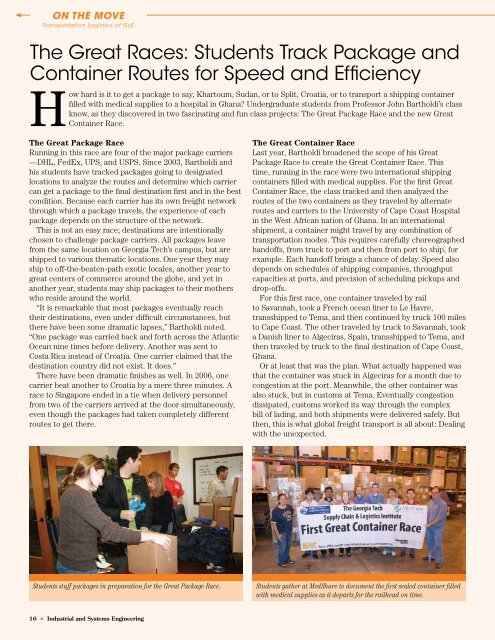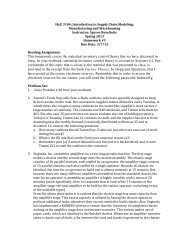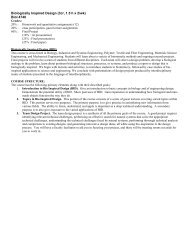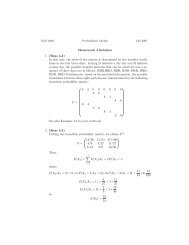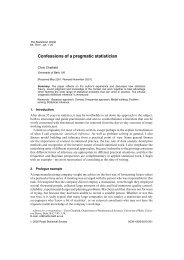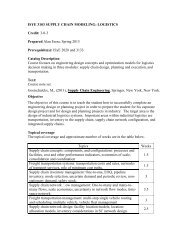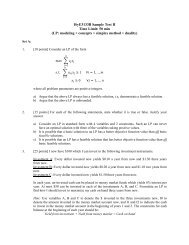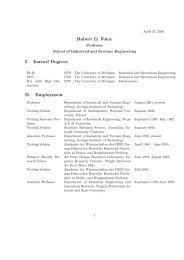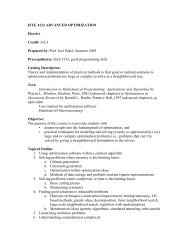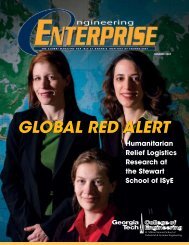Fall 2009 - H. Milton Stewart School of Industrial & Systems ...
Fall 2009 - H. Milton Stewart School of Industrial & Systems ...
Fall 2009 - H. Milton Stewart School of Industrial & Systems ...
You also want an ePaper? Increase the reach of your titles
YUMPU automatically turns print PDFs into web optimized ePapers that Google loves.
ON THE MOVE<br />
Transportation Logistics at ISyE<br />
The Great Races: Students Track Package and<br />
Container Routes for Speed and Efficiency<br />
How hard is it to get a package to say, Khartoum, Sudan, or to Split, Croatia, or to transport a shipping container<br />
filled with medical supplies to a hospital in Ghana? Undergraduate students from Pr<strong>of</strong>essor John Bartholdi’s class<br />
know, as they discovered in two fascinating and fun class projects: The Great Package Race and the new Great<br />
Container Race.<br />
The Great Package Race<br />
Running in this race are four <strong>of</strong> the major package carriers<br />
—DHL, FedEx, UPS, and USPS. Since 2003, Bartholdi and<br />
his students have tracked packages going to designated<br />
locations to analyze the routes and determine which carrier<br />
can get a package to the final destination first and in the best<br />
condition. Because each carrier has its own freight network<br />
through which a package travels, the experience <strong>of</strong> each<br />
package depends on the structure <strong>of</strong> the network.<br />
This is not an easy race; destinations are intentionally<br />
chosen to challenge package carriers. All packages leave<br />
from the same location on Georgia Tech’s campus, but are<br />
shipped to various thematic locations. One year they may<br />
ship to <strong>of</strong>f-the-beaten-path exotic locales, another year to<br />
great centers <strong>of</strong> commerce around the globe, and yet in<br />
another year, students may ship packages to their mothers<br />
who reside around the world.<br />
“It is remarkable that most packages eventually reach<br />
their destinations, even under difficult circumstances, but<br />
there have been some dramatic lapses,” Bartholdi noted.<br />
“One package was carried back and forth across the Atlantic<br />
Ocean nine times before delivery. Another was sent to<br />
Costa Rica instead <strong>of</strong> Croatia. One carrier claimed that the<br />
destination country did not exist. It does.”<br />
There have been dramatic finishes as well. In 2006, one<br />
carrier beat another to Croatia by a mere three minutes. A<br />
race to Singapore ended in a tie when delivery personnel<br />
from two <strong>of</strong> the carriers arrived at the door simultaneously,<br />
even though the packages had taken completely different<br />
routes to get there.<br />
The Great Container Race<br />
Last year, Bartholdi broadened the scope <strong>of</strong> his Great<br />
Package Race to create the Great Container Race. This<br />
time, running in the race were two international shipping<br />
containers filled with medical supplies. For the first Great<br />
Container Race, the class tracked and then analyzed the<br />
routes <strong>of</strong> the two containers as they traveled by alternate<br />
routes and carriers to the University <strong>of</strong> Cape Coast Hospital<br />
in the West African nation <strong>of</strong> Ghana. In an international<br />
shipment, a container might travel by any combination <strong>of</strong><br />
transportation modes. This requires carefully choreographed<br />
hand<strong>of</strong>fs, from truck to port and then from port to ship, for<br />
example. Each hand<strong>of</strong>f brings a chance <strong>of</strong> delay. Speed also<br />
depends on schedules <strong>of</strong> shipping companies, throughput<br />
capacities at ports, and precision <strong>of</strong> scheduling pickups and<br />
drop-<strong>of</strong>fs.<br />
For this first race, one container traveled by rail<br />
to Savannah, took a French ocean liner to Le Havre,<br />
transshipped to Tema, and then continued by truck 100 miles<br />
to Cape Coast. The other traveled by truck to Savannah, took<br />
a Danish liner to Algeciras, Spain, transshipped to Tema, and<br />
then traveled by truck to the final destination <strong>of</strong> Cape Coast,<br />
Ghana.<br />
Or at least that was the plan. What actually happened was<br />
that the container was stuck in Algeciras for a month due to<br />
congestion at the port. Meanwhile, the other container was<br />
also stuck, but in customs at Tema. Eventually congestion<br />
dissipated, customs worked its way through the complex<br />
bill <strong>of</strong> lading, and both shipments were delivered safely. But<br />
then, this is what global freight transport is all about: Dealing<br />
with the unexpected.<br />
Students stuff packages in preparation for the Great Package Race.<br />
Students gather at MedShare to document the first sealed container filled<br />
with medical supplies as it departs for the railhead on time.<br />
16 • <strong>Industrial</strong> and <strong>Systems</strong> Engineering


